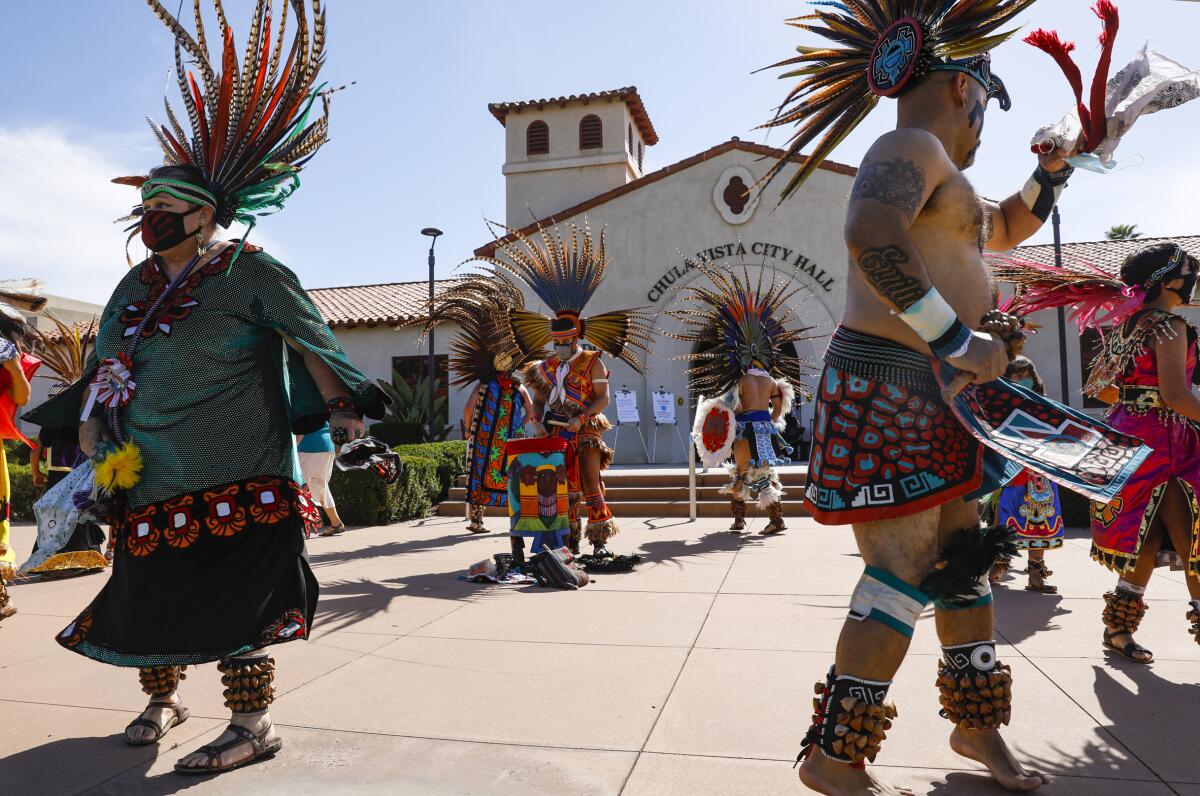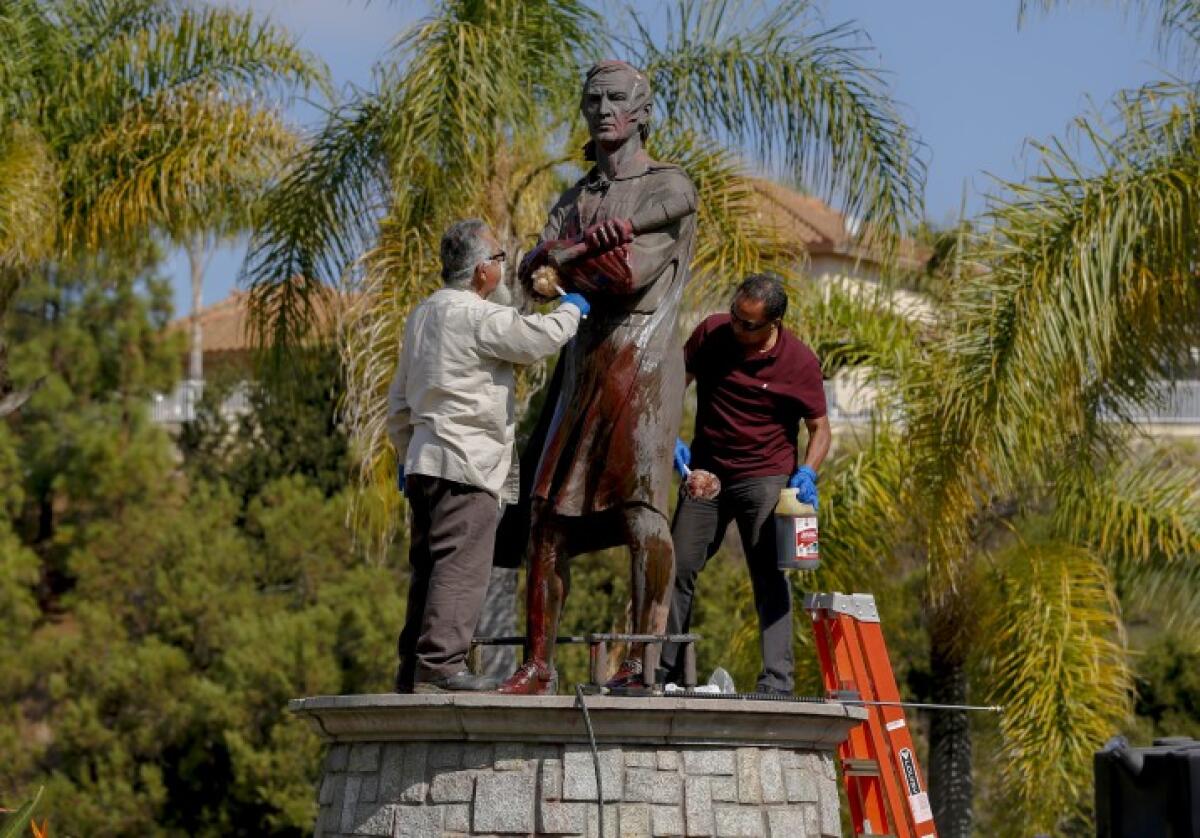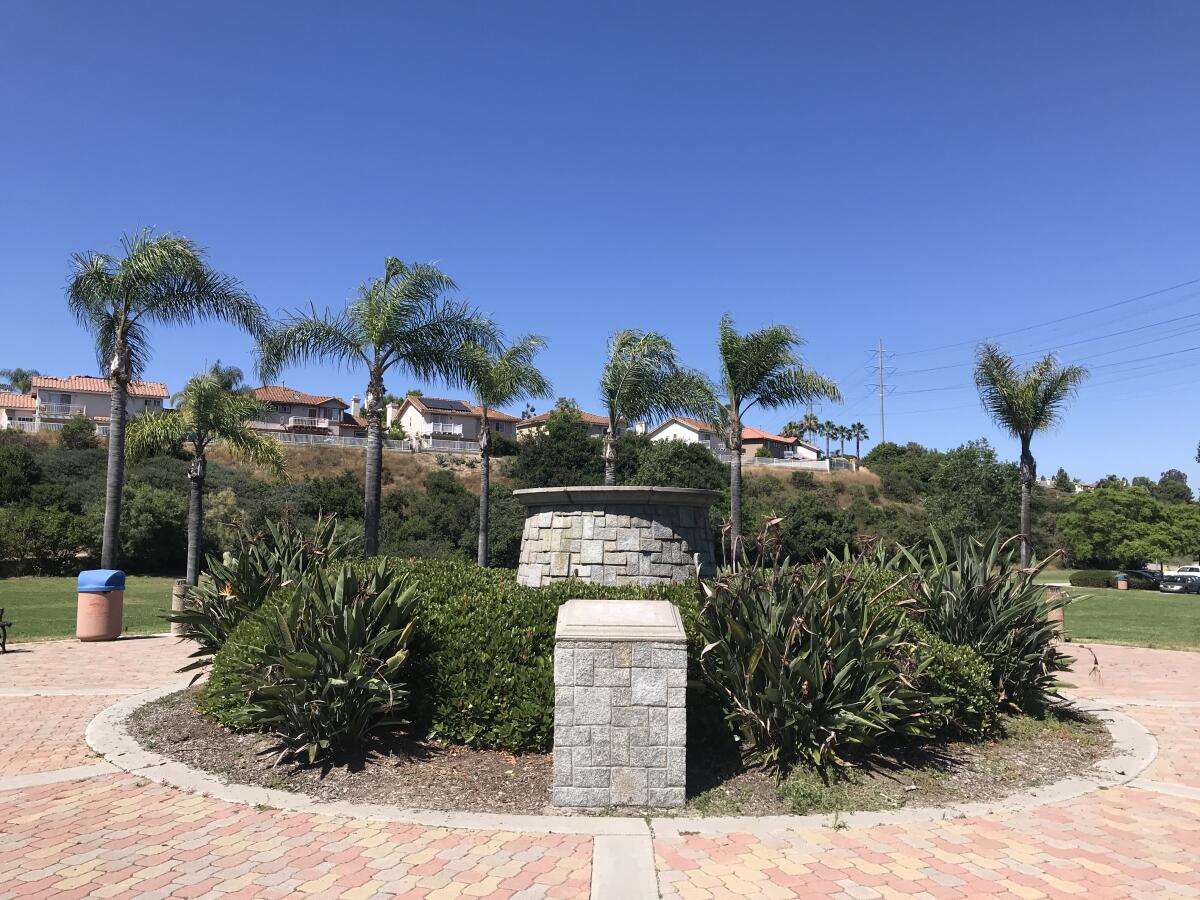Chula Vista park where Columbus statue once stood will be renamed for Kumeyaay Nation

- Share via
SAN DIEGO — Discovery Park in Chula Vista’s Rancho del Rey community, where a Christopher Columbus statue stood for 30 years, will be renamed Kumeyaay Park of Chula Vista.
Chula Vista council members unanimously approved the renaming on Tuesday, a designation they said recognizes the Kumeyaay people, who are native to the region with 13 reservations.
The City Council also agreed that the statue, which has been in storage for two years after repeatedly being targeted by vandals, will be returned to the artist’s heirs or to a local developer who commissioned the sculpture. The city has yet to decide what, if anything, will take its place.
Stan Rodriguez, a director and professor at Kumeyaay Community College, submitted one of four proposed name changes for the park: Mat Tipaay, Kumeyaay for “The Peoples Land.” Even though his proposal wasn’t selected, the Iipay Nation of Santa Ysabel tribal member was ecstatic upon hearing news about the name change.
“It corrects a romanticized, historical fantasy that these lands were ‘discovered,’ ” he said. “It brings to light what has happened with encroachment and the struggle of the Native peoples of these lands to keep our culture, our values, our language, all these things alive in the face of attempts at termination, assimilation and even extermination.”
The efforts to rename Discovery Park and remove the Columbus statue follow decades of advocacy by Indigenous community members.
The Italian explorer, once heralded for his voyages to the New World, has long been viewed as one of the primary forefathers of the genocide of Indigenous peoples throughout North and South America. Indigenous activists nationwide have worked to change Columbus Day to Indigenous People’s Day and to remove statues in his honor, such as the one that was in Discovery Park.
The effort in Chula Vista has been led in part by the Kanap Kuahan Coalition, a group that aims to remove the monuments while raising awareness of their negative impact. Kanap Kuahan means “to tell the truth” in the Kumeyaay language.
In response to the murder of George Floyd in 2020 and the social justice protests that followed, activists across the country tore down or removed monuments of controversial historical figures, such as Confederate leaders. Hours before a protest was set to start at Discovery Park, Chula Vista removed the Columbus statue.
In May 2021, the Chula Vista City Council voted 4-1, with Councilmember John McCann opposed, to permanently keep the statue down and have a task force decide its fate.
Since 1990, the 6-foot-tall bronze monument stood atop a granite pedestal at the park in what would eventually become the Rancho del Rey community. The 1,200-pound sculpture was created by the late artist Mario Zamora Alcantara and commissioned for $100,000 by homegrown developer the Corky McMillin Companies.

The artist’s daughter inquired about the sculpture’s status but did not respond to subsequent requests from the city, according to city staff.
Tuesday’s vote directed staff to send the daughter a 30-day notice as a final opportunity to take the statue back. Otherwise, it will be given to McMillin Companies with the condition that it remain in a private location out of public view.
Task force members had suggested a different option.
After a year’s worth of meetings, the Christopher Columbus and Discovery Park Task Force recommended Tuesday that the statue remain in city storage for three years and then begin accepting submissions using a framework they also created during the past year.
“I think the council was very clear in their wanting to be a final resolution on this and that’s really the work of the task force as well,” said Mayor Mary Casillas Salas. “To me, putting it in storage for three years and then bringing it back for more work is just a continuation of indecision.”
Task force members arrived at their decision last month after rejecting a lone proposal from the San Diego Sons and Daughters of Italy. They declined the organization’s statement of interest saying it was unclear whether the statue would remain in a permanent location and that it lacked details on how the organization would contextualize the monument.
Eve Mazzarella, a Sons and Daughters board member, disagreed with the rejection. In a written comment to the City Council, she said the organization would have addressed the task force’s points of concern without having to wait three years before resubmitting an application.
No other statement of interest was received, but the McMillin Companies expressed interest via public comment, saying they would keep it on private property. The task force did not consider their inquiry, however, because it was not formally submitted through their statement process.
Council members agreed the artist’s family or McMillin Companies would be the most appropriate for ownership.
In addition to suggesting a new park name, the task force was supposed to develop and propose city rules for receiving or installing public monuments and naming or renaming city assets.
The policy gives the city manager power to reject or forward a proposal for further review. If approved for review, the proposal would be considered by a city commission and the city manager would make a final decision. The City Council would step in if there was an appeal.
The City Council adopted the framework Tuesday and agreed on language task force members recommended be placed at the site of the former Columbus statue.

The empty pedestal in Chula Vista shortly after the Christopher Columbus statue was removed.
The language states that a statue of Christopher Columbus once stood on the site but that it was removed and the park was renamed after years of protests by local Kumeyaay and Indigenous advocates.
“We offer this in the spirit of not ‘erasing history,’ but rather as a necessary and reciprocal healing of the harms and injustice of colonial erasure and the distortion of history,” reads the language.
More to Read
Sign up for Essential California
The most important California stories and recommendations in your inbox every morning.
You may occasionally receive promotional content from the Los Angeles Times.












